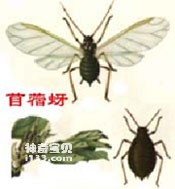Many families like to grow flowers and grass on their balconies or courtyards. If your garden is full of spring colors and blooming flowers, flower-visiting insects will frequently visit. These insects are just guests. Colorful insects can also make your yard lively and add to the beauty of spring. However, some flower pests will settle down and reproduce. From now on, the flowers are no longer bright and the branches and leaves are no longer lush, which makes you troubled. Common flower pests include:

(1) Aphids. Although aphids stay quietly on flowers and leaves, they actually cause considerable harm to flowers! There are many types of aphids on flowers, and the common ones are cotton aphid, long-tubed aphid, chrysanthemum long-tubed aphid, rose long-tubed aphid, and meadowfoam. Aphids etc. Cotton aphids mainly harm citrus, pomegranate, chrysanthemum, hibiscus and many other plants. There are more than 4,000 known species of aphids in the world, and there are more than 600 species in my country. Most of them are crop pests and also harm flowers.
Aphids have piercing-sucking mouthparts that suck plant nutrients, often causing leaves to curl and shrink. In addition, there are abdominal tubes on both sides of the aphid's abdomen, which can discharge "honeydew". This is because after absorbing the sap, it only absorbs part of the nutrients such as protein it needs, and excretes the unnecessary sugar. This "honeydew" "It not only pollutes the surface of plants, but also attracts ants and transmits other diseases, which is very detrimental to the garden environment.

(2) Scale insects. Scale insects come in various shapes, including round, elongated, filamentous, linear, etc. They usually lie on flower plants. Some secrete wax to cover themselves, while others secrete white powder to decorate themselves. There are about 6,000 known species of scale insects in the world, and there are about 600 species in my country, many of which are related to garden fruit trees.
Cotton-blowing scales are the most common damage to garden flowers and trees. They often lie on flower branches seemingly motionless, surrounded by round insects wrapped in light yellow sponge wax. Male insects have wings and often fly indoors and lie on the wall. Cotton-blowing scale insects can damage osmanthus, magnolia, peony, rose, rose, pomegranate, crabapple, nandina, wisteria and other flowers and trees, and have a wide range of hosts.

(3) Deer moth. Also known as the bag moth or debt avoidance moth, it belongs to the family Lepidoptera and the family Trichodermaidae. In late autumn and early winter, when the branches of flowers are bare, it is common to see damask moths hanging on the branches and fluttering in the wind. Female adults live in seclusion in bags or nest tubes throughout their lives, where they mate and lay eggs. Male adults have wings and are good at flying. After the larvae hatch in the bag, they spin silk and spread in the wind, feeding on the leaf mesophyses, causing the plant leaves to wither. In years when high temperatures and drought last for a long time, their harm is also serious. The damselfish moth that harms garden flowers and trees is also known as the giant skin moth. It mainly harms 600 kinds of plants such as wintersweet, plum blossom, rose, rose, peony and so on.
Prevention and control methods: You can use a brush dipped in diluted garlic juice to brush off aphids; or use a soft brush to gently brush off scale insects; or manually remove the cysts of scale insects; or use dilute washing powder on the leaves to remove mealybugs, etc. , can be combined with pruning and cutting off insect branches. If the pests occur in large quantities, you can use 80% dichlorvos emulsion diluted 1000-1500 times to kill aphids, diluted 800 times to kill clown moths, and dilute 1000 times to kill scale insects formed by the end of the shell.
animal tags: Flowers pests aphids control
We created this article in conjunction with AI technology, then made sure it was fact-checked and edited by a Animals Top editor.